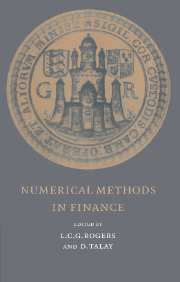Book contents
- Frontmatter
- Contents
- Contributors
- Introduction
- Convergence of Numerical Schemes for Degenerate Parabolic Equations Arising in Finance Theory
- Continuous-Time Monte Carlo Methods and Variance Reduction
- Recent Advances in Numerical Methods for Pricing Derivative Securities
- American Options: A Comparison of Numerical Methods
- Fast, Accurate and Inelegant Valuation of American Options
- Valuation of American Option in a Jump-diffusion Models
- Some Nonlinear Methods for Studying Far-from-the-money Contingent Claims
- Monte Carlo Methods for Stochastic Volatility Models
- Dynamic Optimization for a Mixed Portfolio with Transaction Costs
- Imperfect Markets and Backward Stochastic Differential Equations
- Reflected Backward SDEs and American Options
- Numerical Methods for Backward Stochastic Differential Equations
- Viscosity Solutions and Numerical Schemes for Investment/Consumption Models with Transaction Costs
- Does Volatility Jump or Just Diffuse? A Statistical Approach
- Martingale-Based Hedge Error Control
- The Use of Second-Order Stochastic Dominance To Bound European Call Prices: Theory and Results
Dynamic Optimization for a Mixed Portfolio with Transaction Costs
Published online by Cambridge University Press: 05 June 2012
- Frontmatter
- Contents
- Contributors
- Introduction
- Convergence of Numerical Schemes for Degenerate Parabolic Equations Arising in Finance Theory
- Continuous-Time Monte Carlo Methods and Variance Reduction
- Recent Advances in Numerical Methods for Pricing Derivative Securities
- American Options: A Comparison of Numerical Methods
- Fast, Accurate and Inelegant Valuation of American Options
- Valuation of American Option in a Jump-diffusion Models
- Some Nonlinear Methods for Studying Far-from-the-money Contingent Claims
- Monte Carlo Methods for Stochastic Volatility Models
- Dynamic Optimization for a Mixed Portfolio with Transaction Costs
- Imperfect Markets and Backward Stochastic Differential Equations
- Reflected Backward SDEs and American Options
- Numerical Methods for Backward Stochastic Differential Equations
- Viscosity Solutions and Numerical Schemes for Investment/Consumption Models with Transaction Costs
- Does Volatility Jump or Just Diffuse? A Statistical Approach
- Martingale-Based Hedge Error Control
- The Use of Second-Order Stochastic Dominance To Bound European Call Prices: Theory and Results
Summary
Introduction
We consider a model of n risky and one risk-free asset in which the dynamics of the prices of the risky assets are governed by logarithmic Brownian motions (LBM). Risky assets are conventionally called Stocks while the risk-free asset is called a Bond or Bank. Modelling the stock prices by LBM goes back to Black & Scholes (1973). Since the paper by Merton (1971), in which a dynamic optimization consumption/investment model was introduced, there has been a lot of effort expanded to develop and perfect the LBM models.
One of the avenues of research deals with the transaction cost problem: Consider an investor who has an initial wealth invested in Stocks and Bonds and who has the ability to transfer funds between the assets. This transfer involves brokerage fees (transaction costs).
In one type of model the proceeds from these operations are used to finance the consumption and the objective is to maximize the cumulative expected utility of consumption over a finite or infinite time horizon (see Davis & Norman 1990, Akian, Menaldi & Sulem 1996, Fleming & Soner 1992, Shreve & Soner 1994, Zariphopoulou 1989). In Akian, Sulem & Séquier (1995), a similar problem is considered but on a finite horizon and without consumption. In Sethi & Taksar (1988) and Akian, Sulem & Taksar (1996), the objective is to maximize the long run average growth of wealth.
Mathematicaly, these problems can be formulated as singular stochastic control problems.
- Type
- Chapter
- Information
- Numerical Methods in Finance , pp. 165 - 180Publisher: Cambridge University PressPrint publication year: 1997
- 6
- Cited by



